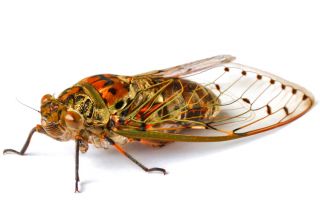Beauty
Searching for Cicada Shells
Continuity and change are everywhere. Just look.
Posted September 12, 2013

Cicada shell

Cicada
We study the bark of each and every tree in the yard. Gianna, 4, takes the lead, while Makayla, 2, follows. Today we strike it rich, finding five cicada shells which Grandma places carefully in a zip lock bag. The shells look like tiny prehistoric animals with little gnarled legs. There is a perfect slit up the back of each shell through which the cicada exits and just as quickly disappears, leaving only a shadow of itself behind. We listen to their metallic, buzzing song constantly filling the air from early July to September. But we seldom see them. The girls study the shells, fascinated and just a little bit afraid, like one might feel looking at a holy relic.
When Rachel, Gianna and Makayla’s mommy, was little, she collected cicada shells, too. And when her little sister, Emily, came along, Rachel would decorate her braces and glasses with cicada shells, hoping, I think, to scare her sister, who instead, found it hilarious. Soon Emily started collecting the shells, too.
Each year I listen for the first cicada in early July, and note the discovery in my journal as if it were the first time I had ever heard it.
It’s hard to explain why some things become part of a family’s story. Let’s face it, cicadas aren’t exactly equivalent to births, deaths, weddings, Thanksgiving dinners and the like. Nevertheless, they are markers, for us signposts of both continuity and change. Each year without fail, having lived most of their lives underground, the tiny cicada nymphs build tunnels through which they crawl into the light of day. They then molt on a nearby plant, leaving their delicate skins behind for kids of all ages to discover. The newly emergent cicada has prominent, transparent wings with dark conspicuous veins. The males have loud noisemakers on their abdomen called tymbals. When they contract and then relax the tymbals in rapid succession, they produce the cicada’s unique, loud buzzzzzzzzzzz, much louder than the average bird’s song.
The only things louder than the cicadas are Gianna and Makayla! We watch them just as intently as they watch the cicada shells. We watch them intently because we know from experience that each day, week, month, and year, they are molting, too; shedding their shells, becoming, growing, emerging, slipping out of old skins, stretching their wings, taking flight, buzzing their buzz, and singing their songs.
Watching them reminds me that I am never too old to shed an old layer of skin, crawl out of a shell that no longer fits, make a sound that no one has heard before, and launch myself into some as yet unexplored part of the world around me.
Check out Seaburn's novels by clicking on "more..." under his picture at the top of the page.


